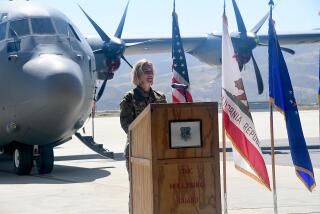State Guard Flying in Latin America for 8 Years, Panel Told
- Share via
SACRAMENTO — Controversy over the role of California National Guard troops in Central America mounted Monday with the disclosure that guardsmen for eight years have flown supplies on non-combat missions throughout Central and South America.
Officials of the state Military Department, testifying before an Assembly budget subcommittee, acknowledged that California guard members have flown military supplies to Honduras and other supplies to U.S. embassies, including the one in Nicaragua.
Members of the Ways and Means subcommittee on state administration, concerned about the use of 30 California guardsmen to stand watch over a road-building project in Honduras, are considering a proposal to write into Gov. George Deukmejian’s proposed state budget a provision that would prohibit California troops from being dispatched to hostile regions, such as Central America.
Several legislators were surprised by the extent of the guard’s involvement in Central and South America, which is wider than that previously disclosed by the Military Department or its commander-in-chief, Deukmejian.
“The governor is putting us in a situation that I don’t think is appropriate,” said Assemblyman Tom Bates (D-Oakland). “I think it’s a mistake to skirt the Congress and deploy people in Central America.”
National Guard officials repeatedly have said that the California guard members are not in a combat situation and face no danger.
With some embarrassment last week, however, the Military Department acknowledged that one California guardsman had fired several shots around midnight on April 24 when someone carrying a light failed to obey commands to halt.
Adjutant General Willard A. Shank told legislators he had no knowledge of an alleged second shooting incident May 4 in which a California guardsman stationed in Honduras purportedly fired his weapon.
“I’m not aware there was any other incident,” Shank told the committee.
Assemblyman Bates, who questioned Shank about the incident, said no details of the episode were available. As with the initial shooting, Bates said, word of the alleged incident came from an anonymous call.
Seeking to explain the role of the California National Guard abroad, Military Department officials said guardsmen had received training in 17 foreign countries since 1970.
Since 1978, 50 members of the Air National Guard have gone to Panama for two weeks at a time to transport supplies to U.S. embassies in capital cities throughout Central and South America, said Col. Tandy Bozeman, noting that he had flown many such missions himself.
California guardsmen have also flown military supplies to Honduras, such as C-rations, nets and tent stakes, Bozeman said. The guardsmen have not transported munitions, he said.
Under questioning from Democratic legislators, Shank also testified that the California National Guard would conceal information on the guard’s activities from the Legislature and even the governor if directed to do so by the federal government.
“The governor has a security clearance, but he doesn’t have the highest type security clearance, as far as I remember,” Shank said.
The Legislature is considering three proposals to limit the guard’s activities in foreign countries: a resolution calling on the governor to bring the guard members back from Honduras; restrictions on the guard’s ability to spend money for such trips; and a constitutional amendment giving the state Senate the authority to oversee deployment overseas.
“If the governor is going to play foreign policy,” Bates said, “we have to have a check.”
More to Read
Sign up for Essential California
The most important California stories and recommendations in your inbox every morning.
You may occasionally receive promotional content from the Los Angeles Times.













